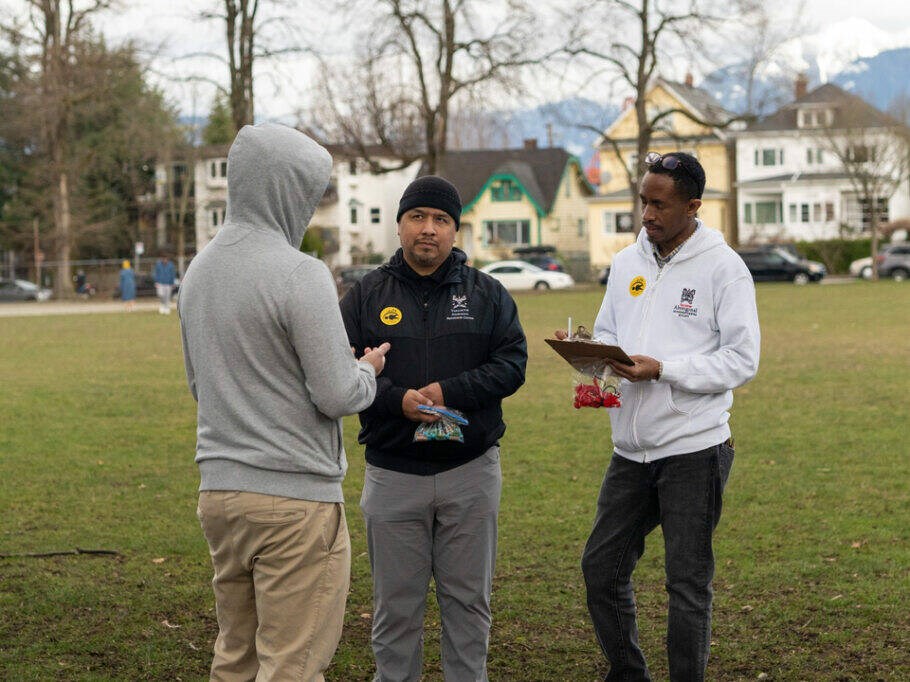The number of people experiencing homelessness on the North Shore has risen sharply over the past three years. Specifically, the number of people experiencing homelessness in North Van and West Van has increased 39 per cent to 168 in 2023, from 121 in 2020.
That’s according to the 2023 Homelessness Count in Greater Vancouver, authored by the Homelessness Services Association of BC. As the previous count was held just a week before the COVID-19 pandemic was declared a public health emergency, the HSABC says the report represents a timely update on the homelessness situation through the pandemic period.
Across Greater Vancouver, the total number of people experiencing homelessness rose 32 per cent to 4,821, from 3,634 three years ago.
On the North Shore, both the number of sheltered and unsheltered people experiencing homelessness has gone up. In 2023, there were 117 staying in shelters, compared to 75 in 2020. A total of 51 individuals were counted as unsheltered this year, compared to 46 three years ago.
The numbers from this year’s count are heartbreaking, says Megan Kriger, director of development for Lookout Housing and Health Society. “And yet we recognize that this is still a vast underestimate of the actual number of people experiencing homelessness in the Greater Vancouver area.”
“The homeless count numbers illustrate the need for a dramatic increase in affordable housing and poverty reduction measures, with 35 per cent of people providing not enough income as their reason for housing loss, as well as access to Indigenous supports, and addictions and mental health services,” she said.
While strides are being made to bring more affordable housing units online quickly, the need far outweighs what is being built, Kriger said, underscoring the importance of protecting existing low- and middle-income rentals while lowering barriers to building new developments.
“If we want to stop the numbers from continuing to grow and truly support our homeless community members, we need to come together as a community and say, ‘Yes, in my backyard!’ It’s not enough to say we can add housing somewhere,” she said.
One of many dire statistics in the report shows a sharp uptick in the length of time people are spending unhoused. In 2023, the proportion of people experiencing homelessness for a year or more rose to 69 per cent of respondents, compared to 45 per cent in 2020.
Getting people off the street and into housing quickly is “critically important,” Kriger said.
“The longer that people stay unhoused, the more the likelihood that people become ostracized from their community of supports, and have deteriorating mental and physical health,” she said. “In some cases, people are forced to resort to desperate survival methods that can traumatize and dehumanize.”
In North Vancouver, Lookout continues to support the growing demand through innovative programming and community partnerships, Kriger said. That programming includes an expanded outreach program, which is a partnership between the three local municipalities and two First Nations to better reach at-risk individuals.
‘This report will always be an undercount’
Other statistics in the report point to a continued over-representation of Indigenous people in the unhoused population. In 2023, 33 per cent of respondents were Indigenous, while making up just 2.4 per cent of Metro Vancouver’s overall population.
According to a new statistic collected this year, 47 per cent of respondents reported that they were on a waiting list for housing, and 81 per cent of people were in the same community as the last time they were housed.
By co-ordinating with hundreds of community volunteers, shelter staff and people with lived experience of homelessness, HSBAC carried out the “point-in-time” count between the evening of March 7 and the following day.
People were counted if they stayed somewhere overnight – including shelters, transition houses for women fleeing violence, youth safe houses, in hospital with no fixed address, jails and detox facilities – or if they were found by interviewers on March 8 in a place where they didn’t pay rent the previous night, such as an alley, park, vehicle or temporarily at someone else’s place.
“The numbers presented in this report will always be an undercount of the experience of homelessness in the region,” reads the report. “The purpose of the count is to estimate the number of people experiencing homelessness, obtain a demographic profile of those individuals, and identify trends that can be comparable to previous counts that used similar methodology.”




